The Ultimate Guide to Chili Rasbora Care: Mastering the Brilliance of Boraras brigittae
- Family: Cyprinidae
- Scientific name: Boraras brigittae
- Common name: Chili Rasbora, Mosquito Rasbora, Micro Rasbora
- Origin: Asia; Southwestern Borneo, Indonesia
- Max length: 0.8 – 1.0 inch (2 – 2.5 cm)
- Minimum tank size: 10 gallons (approximately 38 liters)
- Stocking: 8-10 fish for a 10-gallon tank
- Temperament: Very peaceful, shy; thrives in groups
- Feeding: Omnivore; accepts live, frozen, and flake foods but requires regular live foods
- Breeding: Very hard; challenging in captivity
- Habitat: Blackwater streams and ponds, Borneo
- Tank setup: Densely planted tank with driftwood, subdued lighting, and dark substrate
- Hangs out: Top 1/3 of the tank; occasionally swims lower
- Care level: Moderate; needs stable conditions
- Temperature: 68.0 – 82.4°F (20 – 28°C); prefers 75-80°F
- pH: 4.0 – 7.0; thrives in acidic water
- Water hardness: GH 1 – 10, KH 5 – 10; very soft water
- Lifespan: 4 – 8 years with optimal care
- Appearances, Temperament, and Interesting Facts
- Tank Setup, Layout, and Stocking
- Tankmates for Chili Rasbora
- Diet, Foods, and Feeding
- Breeding Chili Rasboras
- Diseases and Treatments
- Behavioral Insights and Enrichment
- Troubleshooting Common Issues
- Why Keep Chili Rasboras?
Appearances, Temperament, and Interesting Facts
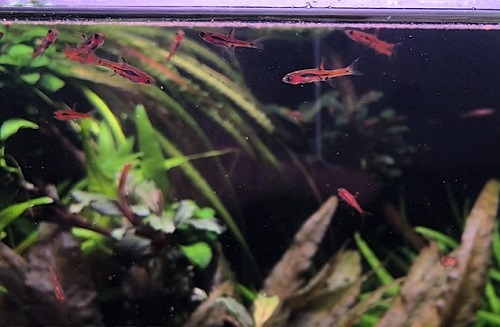
Chili Rasboras (Boraras brigittae) are nano tank royalty, their tiny size—0.8 to 1 inch—belied by a fiery red-orange hue that ignites any small aquarium. Males shine brightest, their slim bodies adorned with a bold black stripe and vivid red fins, intensifying during sparring or courtship. Females, slightly larger and rounder, display a subtler reddish tint with less contrast. Native to Borneo’s blackwater streams, their colors pop against dark substrates, making them perfect for desktop setups where larger tanks might drown their delicate charm.
Also called Mosquito or Micro Rasboras, they’re classic schoolers, moving in tight-knit groups with little interest in human antics. Their shyness is legendary—ours retreat at the slightest disturbance, only emerging in calm, familiar settings. This timidity pairs with a peaceful demeanor, ideal for serene aquascapes. Unlike boisterous fish, they demand patience to appreciate—watch them hover in the top third of the tank, occasionally dipping lower in playful bursts.
Sourcing them can be tricky. In our region, they’re seasonal, and orders often yield surprises—Phoenix Rasboras (Boraras merah) or Exclamation Point Rasboras (Boraras urophthalmoides) instead. After two mix-ups, our third order finally delivered true Chilis, their brilliance worth the wait. Buy from breeders for certainty—their rarity adds to their allure. Fun fact: their red hue may mimic toxic insects in the wild, deterring predators—a trait that dazzles in captivity.
Tank Setup, Layout, and Stocking
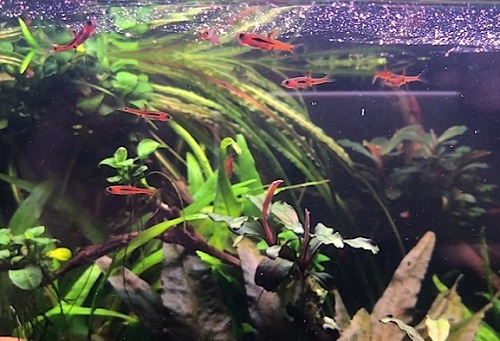
Chili Rasboras thrive in a 10-gallon tank, but a 15-20 gallon long tank suits their schooling and top-dwelling habits better. Blackwater natives, they crave dim lighting—use low-intensity LEDs or floating plants like Salvinia, Azolla, or duckweed to soften glare. A dark substrate (black sand, fine gravel) mirrors their peat-rich ponds, amplifying their red glow. Dense planting—Java moss, Cryptocoryne wendtii, or Eleocharis—is essential, offering cover and calm. Driftwood roots or branches overhead replicate overhanging vegetation, a comfort they adore.
Scatter catappa (Indian almond) leaves or dried oak leaves across the bottom—they release tannins, lowering pH to their preferred 4.0-7.0 (aim for 5.5-6.5) and mimicking Borneo’s tea-stained waters. These leaves also curb fungi and bacteria, boosting health. Avoid peat—it’s less sustainable—and ensure leaves are pesticide-free. Water stays soft (GH 1-10, KH 5-10) and warm (75-80°F within 68-82.4°F range). A gentle sponge filter or low-flow hang-on-back keeps currents minimal—they dislike turbulence.
Stock 8-10 in a 10-gallon for cohesion; fewer risks withdrawal. In a 20-gallon, 15-20 Chilis create a stunning school, their synchronized dance a nano tank highlight. Weekly 20-30% water changes maintain stability—never introduce them to an uncycled tank. Their moderate care level stems from these precise needs, rewarding attentive keepers with longevity up to 8 years.
Tankmates for Chili Rasbora
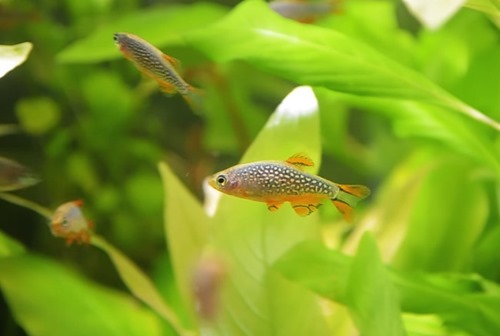
Celestial Pearl Danios
Chili Rasboras are timid souls, shrinking from bold or large tankmates. Happy in their element, they turn gregarious, their red intensifying as males spar lightly. A species-only tank with 8-10 fish is ideal—safety in numbers curbs shyness, revealing their true nature. Too few, and they fade into recluses; in abundance, they dazzle.
In community setups, choose peaceful micros: Kubotai Rasboras (Microdevario kubotai), Celestial Pearl Danios, Sundadanio axelrodi, Espei Rasboras, Pygmy Corydoras, and Otocinclus. Avoid aggressive fish (e.g., bettas, barbs) or anything big enough to swallow them (e.g., gouramis). Dwarf shrimp—Orange Sakura, Red Cherry—are perfect pals; even shrimplets evade their tiny mouths, coexisting indifference intact.
In a 10-gallon, pair 10 Chilis with 6-8 shrimp; in a 20-gallon, add 5-6 Kubotai Rasboras and 4 Pygmy Cories. Their top-third focus leaves lower levels for bottom-dwellers, balancing the tank. Introduce Chilis last to settled communities—they’re too timid for pioneering.
Diet, Foods, and Feeding
Chili Rasboras aren’t fussy omnivores, accepting flake and micro pellet foods (e.g., Fluval Bug Bites Micro Granules), but live and frozen foods are vital for health and color. Favorites include baby brine shrimp, vinegar eels, micro worms, mosquito larvae, daphnia, and chopped blackworms. Frozen options—rotifers, cyclops, tubifex, brine shrimp—offer convenience. Feed small portions 1-2 times daily, targeting the top third; their tiny mouths need micro-sized fare—avoid oversized pellets like New Life Spectrum.
Live foods mimic their wild diet of micro-invertebrates, boosting vitality and breeding readiness. Alternate daily—flakes one day, live brine shrimp the next—to keep them engaged. They’ll nibble tank algae, but don’t expect cleanup duty. Overfeeding clouds their soft water; remove excess within 10 minutes. Their dietary flexibility suits beginners, but regular live treats elevate them to brilliance.
Breeding Chili Rasboras
Breeding Chili Rasboras is a tough nut—success is rare in captivity. They’re egg-scatterers, laying 10-20 tiny eggs among plants or spawning mops in acidic, soft water (pH 5.0-6.0, GH 1-5). Males flare red, chasing females in courtship, but spawning lacks fanfare. A 10-gallon breeding tank with dense Java moss, catappa leaves, and a sponge filter sets the stage. Condition with live foods (brine shrimp, micro worms) for 2-3 weeks; dim lights and warm water (78-80°F) nudge them along.
Eggs hatch in 3-5 days into minuscule fry, free-swimming by day 7-8. Adults may eat them—separate eggs or fry to a rearing tank with infusoria or liquid fry food for 2 weeks, then baby brine shrimp. Survival rates are low without meticulous care; they mature at 4-6 months. This challenge suits advanced keepers, but their beauty justifies the effort.
Diseases and Treatments
Chili Rasboras are hardy yet sensitive to water shifts—ich, fin rot, and velvet plague stressed fish. Ich (white spots) treats with heat (82°F) and salt (1 tsp/gallon) for 7-10 days; half-dose malachite green works too. Fin rot (ragged fins) needs clean water and API’s Melafix—severe cases call for antibiotics. Velvet (gold dust) requires copper-free meds (e.g., Seachem ParaGuard) and dark conditions. Quarantine new arrivals 2-3 weeks; weekly catappa leaf tea or garlic food prevents woes.
Behavioral Insights and Enrichment
Their shyness hides a schooling grace—watch them weave through plants, red flashes against green. Add floating toys or adjustable lights to spark curiosity; gentle bubbles amuse without alarm. In a 15-gallon blackwater tank, 12 Chilis school atop driftwood, paired with 8 shrimp and 5 Pygmy Cories—a living jewel box. Their top focus balances with bottom-dwellers, creating harmony.
Troubleshooting Common Issues
– **Hiding**: Increase school size or dim lights—check tankmate aggression.
– **Dull Colors**: Up live food intake; test pH (aim 5.5-6.5).
– **No Breeding**: Lower pH to 5.0, add spawning mops, and feed live.
– **Fry Loss**: Isolate eggs early; ensure micro-food supply.
Why Keep Chili Rasboras?
Their petite size fits nano budgets—a 10-gallon setup runs $80-100, yielding years of vivid red wonder. With a 4-8 year lifespan, they’re a long-term joy, their schooling dance a daily delight. Hard to breed but easy to love, they elevate small tanks into blackwater masterpieces, proving micro fish pack macro impact.

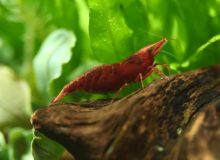
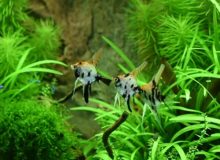
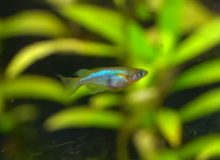
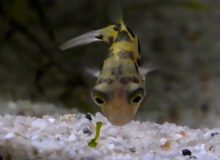
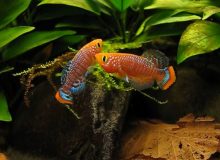
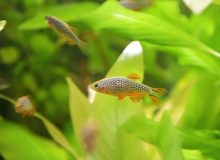
Leave a Reply